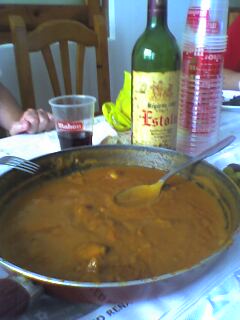Gachas




Gachas is a traditional dish originating from the Iberian Peninsula, specifically from the central and southern regions of Spain. This rustic meal is deeply rooted in the agricultural and shepherd communities, reflecting the simplicity and resourcefulness of traditional Spanish cuisine. Gachas is primarily known for its comforting and hearty characteristics, making it especially popular during the colder months.
Ingredients and Preparation[edit]
The basic ingredients of gachas include water, flour (traditionally made from millet or wheat), salt, and olive oil. Variants of the dish may incorporate garlic, paprika, and other local spices to enhance flavor. Additionally, gachas can be enriched with meat products such as bacon, chorizo, or rabbit, and sometimes includes legumes like beans or lentils for added nutrition and texture.
The preparation of gachas begins with heating olive oil in a pan, to which garlic and spices are added and sautéed until fragrant. Flour is then stirred in, followed by water, to create a thick, porridge-like consistency. The mixture is seasoned with salt and cooked on low heat, stirring continuously to prevent lumps from forming. The dish is served hot, often garnished with fried garlic slices, meats, or fresh herbs.
Cultural Significance[edit]
Gachas has been a staple in the diet of Spanish rural communities for centuries, serving as an economical and filling option that utilizes readily available ingredients. Its significance goes beyond mere sustenance; gachas is a symbol of communal gathering and sharing. It is not uncommon for gachas to be prepared in large quantities and consumed during communal meals, festivals, and other social gatherings, fostering a sense of community and belonging.
Regional Variations[edit]
While the basic concept of gachas remains consistent, regional variations abound throughout Spain, reflecting the diversity of Spanish culinary traditions. For example, in Andalusia, gachas is often served with a topping of honey and nuts, adding a sweet contrast to the savory base. In the Manchego region, gachas manchegas is a popular variant that includes pieces of chorizo and bacon, offering a richer and more robust flavor profile.
Modern Interpretations[edit]
Today, gachas continues to be cherished in Spain, with both traditional recipes and modern interpretations enjoyed by people of all ages. Contemporary chefs and home cooks alike experiment with different types of flour, such as cornmeal or buckwheat, and incorporate a variety of toppings and sides, from seafood to vegetables, adapting the dish to suit modern palates and dietary preferences.
Conclusion[edit]
Gachas exemplifies the essence of traditional Spanish cuisine—simple ingredients, communal eating, and a deep connection to regional agricultural practices. As it evolves with contemporary tastes, gachas remains a beloved comfort food, embodying the warmth and generosity of Spanish culture.
Ad. Transform your life with W8MD's Budget GLP-1 injections from $75


W8MD offers a medical weight loss program to lose weight in Philadelphia. Our physician-supervised medical weight loss provides:
- Weight loss injections in NYC (generic and brand names):
- Zepbound / Mounjaro, Wegovy / Ozempic, Saxenda
- Most insurances accepted or discounted self-pay rates. We will obtain insurance prior authorizations if needed.
- Generic GLP1 weight loss injections from $75 for the starting dose.
- Also offer prescription weight loss medications including Phentermine, Qsymia, Diethylpropion, Contrave etc.
NYC weight loss doctor appointmentsNYC weight loss doctor appointments
Start your NYC weight loss journey today at our NYC medical weight loss and Philadelphia medical weight loss clinics.
- Call 718-946-5500 to lose weight in NYC or for medical weight loss in Philadelphia 215-676-2334.
- Tags:NYC medical weight loss, Philadelphia lose weight Zepbound NYC, Budget GLP1 weight loss injections, Wegovy Philadelphia, Wegovy NYC, Philadelphia medical weight loss, Brookly weight loss and Wegovy NYC
|
WikiMD's Wellness Encyclopedia |
| Let Food Be Thy Medicine Medicine Thy Food - Hippocrates |
Medical Disclaimer: WikiMD is not a substitute for professional medical advice. The information on WikiMD is provided as an information resource only, may be incorrect, outdated or misleading, and is not to be used or relied on for any diagnostic or treatment purposes. Please consult your health care provider before making any healthcare decisions or for guidance about a specific medical condition. WikiMD expressly disclaims responsibility, and shall have no liability, for any damages, loss, injury, or liability whatsoever suffered as a result of your reliance on the information contained in this site. By visiting this site you agree to the foregoing terms and conditions, which may from time to time be changed or supplemented by WikiMD. If you do not agree to the foregoing terms and conditions, you should not enter or use this site. See full disclaimer.
Credits:Most images are courtesy of Wikimedia commons, and templates, categories Wikipedia, licensed under CC BY SA or similar.
Translate this page: - East Asian
中文,
日本,
한국어,
South Asian
हिन्दी,
தமிழ்,
తెలుగు,
Urdu,
ಕನ್ನಡ,
Southeast Asian
Indonesian,
Vietnamese,
Thai,
မြန်မာဘာသာ,
বাংলা
European
español,
Deutsch,
français,
Greek,
português do Brasil,
polski,
română,
русский,
Nederlands,
norsk,
svenska,
suomi,
Italian
Middle Eastern & African
عربى,
Turkish,
Persian,
Hebrew,
Afrikaans,
isiZulu,
Kiswahili,
Other
Bulgarian,
Hungarian,
Czech,
Swedish,
മലയാളം,
मराठी,
ਪੰਜਾਬੀ,
ગુજરાતી,
Portuguese,
Ukrainian
